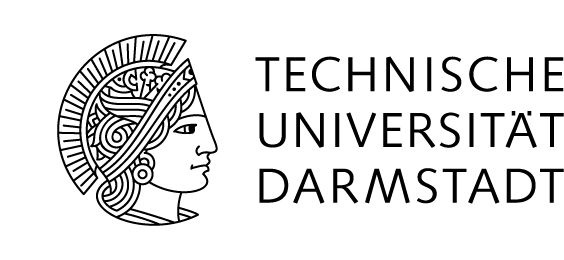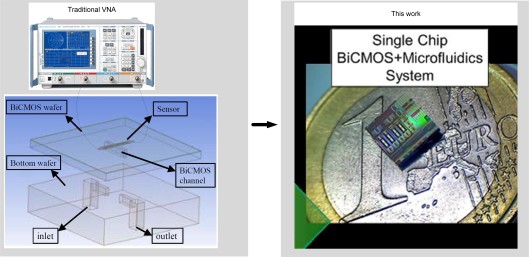Integrated Lab-on-Chip THz Spectroscopy-platform in BiCMOS technology
Phase 1 and 2
Goal of this project is the first-time demonstration of an ultra-broadband fully integrated microfluidic platform featuring terahertz (THz) spectroscopy sensors for future innovative Lab-on-Chip applications. The targeted platform will be realized in a single low-cost mass Manufactural state-of-the-art SiGe BiCMOS technology combining integrated complex THz vector network analyzer sensor readout circuits in the 240-500 GHz frequency range realized in the front-end of line (FEOL) technology with THz sensing element implementations and novel microfluidic channel integration in the back-end of line (BEOL) process. The proposed highly integrated demonstration platform will be applicable for studies of the real interaction between biological cells and electromagnetic fields on a single cell interaction level using additionally integrated trapping electrodes.
Project Head:
Prof. Dr.–Ing. Dietmar Kissinger, TU Berlin and IHP
Prof. Dr.–Ing. Bernd Tillack, TU Berlin and IHP
Research Team:
Defu Wang, M.Sc., Circuit Design Department, IHP
Mesut Inac, M.Sc., Berlin Technical University
Dr. Klaus Schmalz, IHP
Matthias Wietstruck, IHP
Dr.–Ing. Canan Baristiran Kaynak, Technology Department, IHP
Dr.–Ing. Mehmet Kaynak, Technology Department, IHP
Objectives
As specifically mentioned in the project call, the real interaction between the electromagnetic fields and cells has not been well studied yet due to the lack of repeatability and sufficient experimental conditions. The main challenges and the proposed solutions are:
1. Achieving mm–wave or THz signals is not straightforward and there is a need for special technologies such as III-V compound semiconductor technologies. However, these technologies are very costly and only applicable for specific small-volume applications.
In THz-LoC, we are proposing the world’s highest performance (highest fmax) BiCMOS technology for THz signal generation and detection. Such BiCMOS technologies are very cost effective and suitable for high-volume production.
2. Sensing at mm-wave and THz frequencies needs a very close interaction between the signal source and the fluid. However, there is no available device or technology platform coupling the THz signal sources with fluidic channels.
In THz-LoC, we are proposing a BiCMOS+Microfluidic combined technology. This technology platform is a unique opportunity because it provides the shortest connection between the fluid and the sensor in BiCMOS process. Furthermore, it significantly minimizes the overall system size which eliminates undesired effects.
3. Analyses of specific fluids at THz frequencies provides many information; however most measurements are inherently limited to a bulk part of the fluid, but not the cells in the fluid. Therefore, the need of analyzing single cells is still emerging and no real solution is available. This task is extremely challenging because the cell size differs from few micrometers to few tens of micrometers, which has to be kept and analyzed in a controllable manner.
In THz-LoC, a single cell level analysis is proposed. Cells with an approximate diameter of 10– 20 μm will be trapped and analyzed. The details are given in the next section.
4. Although the generation of THz signals and measurements of different samples have been demonstrated in literature, all these measurements are achieved using very bulky and expensive measurement devices (i.e. network analyzers) or scalar measurement setups:
In THz-LoC, a fully BiCMOS integrated on-chip network analysis solution is proposed. By the help of the fully integrated network analyses, the information which is sensed at THz frequencies will be directly analyzed in the chip in order to achieve the most accurate data. Considering the very high attenuation at these frequencies, a direct analysis of the signal in the chip is the only and best solution.
5. In the last few years, many demonstrations on characterization of fluids at RF and mm-wave frequencies have been performed. However, the main breakthrough is expected if the single cell analyses can be done at mm-wave and THz frequencies. The challenge of trapping single cells and analyzing them at mm-wave and THz frequencies is still open and no solution is available.
In THz-LoC, a novel THz sensor including electrodes for trapping and sensing is proposed. Using this method, single cells will be trapped by the help of electrodes and low-frequency signals required for trapping and another electrode pair for RF (THz) sensing to analyze the trapped cell. The details of the proposed method are given in the next section.
In conclusion, the main objective of the proposal is the development of a technology platform for mm-wave and THz sensing using a state-of-the-art BiCMOS technology. The target application is specifically at the cell level. Demonstration and feasibility of the different sub-components of a microfluidic system required for THz sensing is also one of the main objectives of this proposal. Figure 13 summarizes the main goal of THz-LoC project.
Abstract
Goal of this project is the first-time demonstration of an ultra-broadband fully integrated microfluidic platform featuring terahertz (THz) spectroscopy sensors for future innovative Lab-on-Chip applications. The targeted platform will be realized in a single low-cost mass Manufactural state-of-the-art SiGe BiCMOS technology combining integrated complex THz vector network analyzer sensor readout circuits in the 240-500 GHz frequency range realized in the front-end of line (FEOL) technology with THz sensing element implementations and novel microfluidic channel integration in the back-end of line (BEOL) process. The proposed highly integrated demonstration platform will be applicable for studies of the real interaction between biological cells and electromagnetic fields on a single cell interaction level using additionally integrated trapping electrodes.
Publications
D. Wang, K.Schmalz, M.H. Eissa, J. Borngraber, M. Kucharski, M. Elkhouly, F.I. Jamal, M. Ko, H.J. Ng, D. Kissinger, “Integrated 240 GHz Dielectric Sensor With DC Readout Circuit in THz Lab-on-Chip Measurements“. IEEE MTT-S Int. Microw. Symp, Honolulu, HI, USA, June, 2017.
D. Wang, K.Schmalz, M.H. Eissa, J. Borngraber, M. Kucharski, M. Elkhouly, F.I. Jamal, M. Ko, H.J. Ng, D. Kissinger, “Integrated 240 GHz Dielectric Sensor with DC Readout Circuit in a 130-nm SiGe BiCMOS Technology“. IEEE Trans. Microw. Theory-submitted.
M. Inac, M. Wietstruck, A. Göritz, B. Cetindogan, C. Baristiran-Kaynak, S. Marschmeyer, M. Fraschke, T. Voss, A. Mai, C. Palego, A. Pothier, M. Kaynak, “BiCMOS Integrated Microfluidic Packaging by Wafer Bonding for Lab-on-Chip Applications” IEEE 67th ECTC, Orlando, FL, USA, June, 2017
M. Inac, M. Wietstruck, A. Göritz, B. Cetindogan, C. Baristiran-Kaynak, M. Lisker, A. Krüger, A. Trusch, U. Saarow, P. Heinrich, T. Voss, M. Kaynak, “Oxide Surface Roughness Optimization of BiCMOS BEOL Wafers for 200 mm Wafer Level Microfluidic Packaging Based on Fusion Bonding”, IEEE 19th EPTC, Singapore, Singapore, December 2017 – Submitted
M. Inac, M. Wietstruck, A. Göritz, B. Cetindogan, C. Baristiran-Kaynak, S. Marschmeyer, M. Fraschke, T. Voss, A. Mai, C. Palego, A. Pothier, M. Kaynak “BiCMOS Embedded Microfluidic Technology Based on Wafer Bonding Techniques for Biosensor Applications” MST Kongress 2017, Munich, Germany, October 2017 – Accepted


